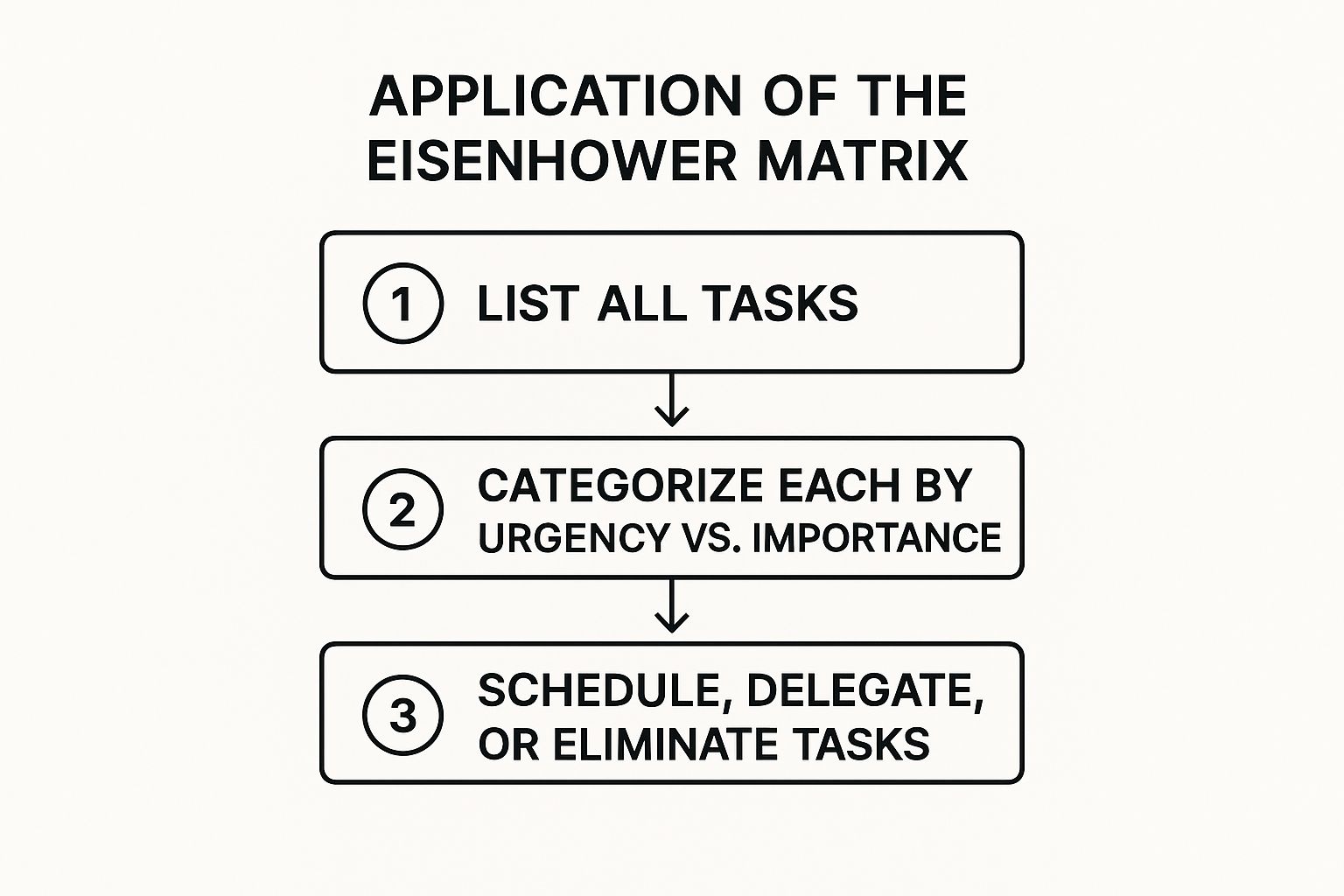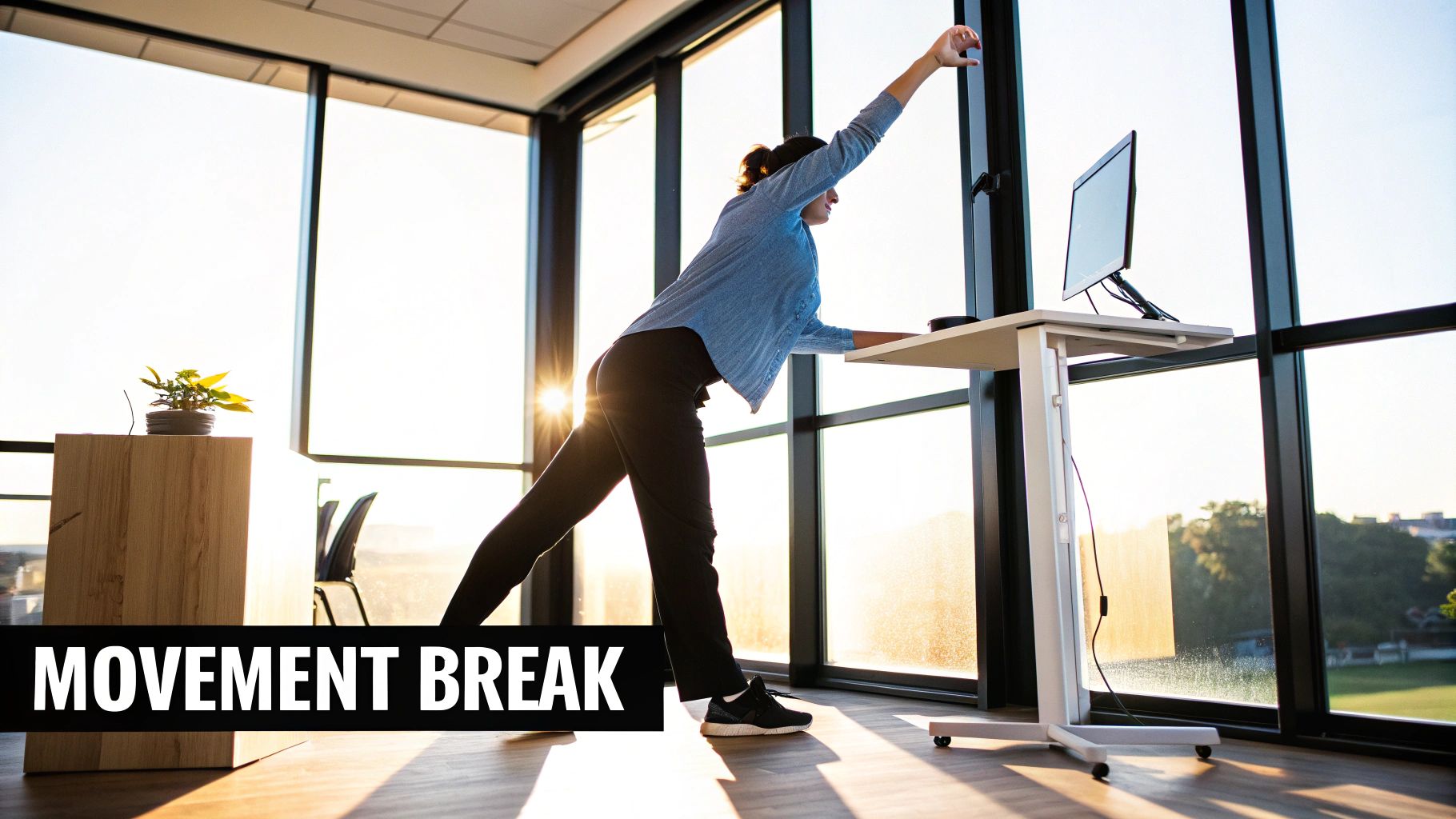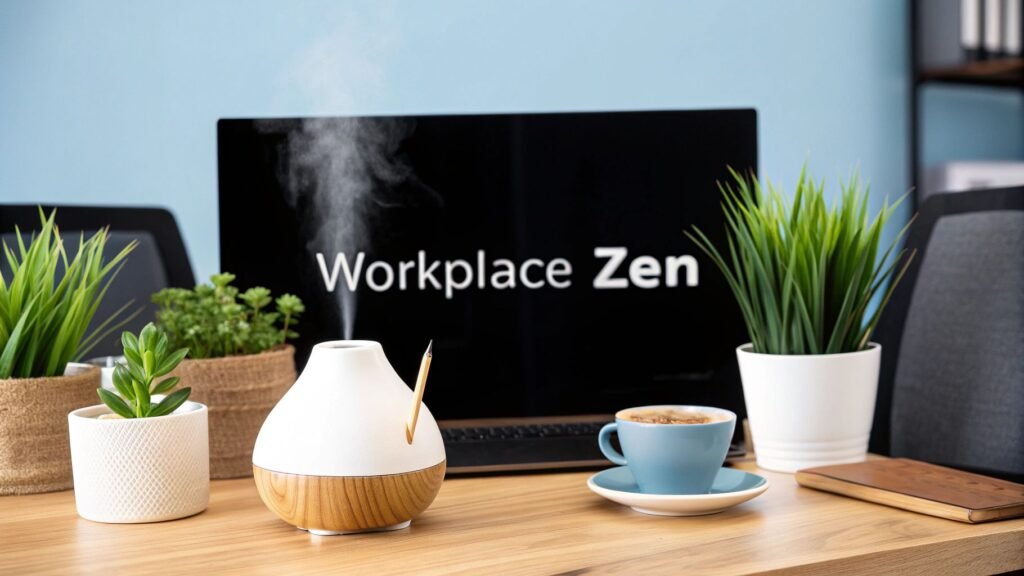Workplace stress has become a pervasive challenge in modern professional life, impacting productivity, health, and overall job satisfaction. The constant pressure of deadlines, high expectations, and an always-on culture can lead to chronic stress and burnout. Managing this pressure is not about eliminating stress entirely, but about building resilience and developing a toolkit of effective strategies. This guide offers a comprehensive roundup of powerful workplace stress management techniques, blending evidence-based psychological tools with practical organizational methods.
This article moves beyond generic advice to provide a clear, actionable framework for reclaiming your professional well-being. You will learn specific, implementable tactics, from mastering prioritization with the Eisenhower Matrix to leveraging the calming effects of Progressive Muscle Relaxation. We will also explore crucial strategies for setting healthy boundaries and building robust social support networks within your professional environment.
These methods are designed to empower you with greater calm, clarity, and control over your daily challenges. To begin building your foundational understanding, explore some additional effective workplace stress reduction tips. Whether you're an individual seeking personal relief or a leader aiming to foster a healthier work environment, the techniques detailed below provide a clear path toward a more balanced and sustainable career.
1. Mindfulness Meditation
Mindfulness meditation is a powerful mental training practice centered on focusing your awareness on the present moment. By calmly acknowledging and accepting your feelings, thoughts, and bodily sensations without judgment, you can effectively disrupt the cycle of rumination that often fuels workplace anxiety. This technique is one of the most accessible and research-backed workplace stress management techniques available, helping to enhance self-awareness and promote profound relaxation.

The corporate world has taken notice of its benefits. Tech giant Google developed the renowned ‘Search Inside Yourself’ program, a mindfulness-based emotional intelligence curriculum now used by thousands of employees. Similarly, insurance company Aetna reported an estimated $3,000 per employee in annual healthcare savings and a 28% reduction in stress levels after implementing its own mindfulness programs. These examples demonstrate the tangible return on investment from integrating meditation into the workplace.
How to Implement Mindfulness at Work
Getting started doesn't require a significant time commitment. The key is consistency, not duration.
- Start Small: Begin with just five minutes of practice each day, perhaps before your first meeting or during your lunch break. You can gradually increase the time as you become more comfortable.
- Use Guided Resources: Apps like Headspace and Calm offer structured, guided meditations specifically designed for work-related stress, focus, and productivity.
- Create a Quiet Space: If possible, advocate for a designated quiet room in the office where employees can disconnect and practice without interruption.
- Focus on the Breath: If your mind feels too busy, simply focus on counting your breaths. Inhale for a count of four, hold for four, and exhale for four. This simple exercise can quickly ground you.
For those looking to deepen their practice, you can explore further mindfulness meditation techniques to boost focus and reduce stress. Remember, the goal is not to eliminate thoughts but to observe them without attachment, fostering a calmer and more resilient mindset.
2. Time Management and Prioritization (Eisenhower Matrix)
Feeling overwhelmed by an endless to-do list is a primary source of workplace stress. The Eisenhower Matrix, also known as the Urgent-Important Matrix, is a powerful framework for regaining control. It helps you categorize tasks based on their urgency and importance, allowing you to focus your energy on activities that deliver the most value and strategically manage everything else. This prioritization method is one of the most effective workplace stress management techniques for transforming a reactive, chaotic workflow into a proactive, focused one.
The influence of this simple matrix is widespread in high-performance environments. Management consultants at firms like McKinsey & Company use priority matrices to manage complex client projects, while Stephen Covey popularized the concept for millions in his book The 7 Habits of Highly Effective People. Even fast-growing startups like Buffer have used similar priority frameworks to navigate the demands of rapid expansion. This method provides a clear, logical system to cut through the noise and reduce the anxiety that comes from feeling constantly behind.
The infographic below illustrates the simple three-step process for applying the Eisenhower Matrix to your daily workload.

This systematic approach of listing, categorizing, and then acting on tasks based on their quadrant provides a clear path to managing your responsibilities without feeling overwhelmed.
How to Implement the Eisenhower Matrix at Work
Integrating this framework into your routine requires a shift from reacting to what feels urgent to focusing on what is genuinely important.
- Categorize Daily: Start each day or week by listing all your tasks and assigning them to one of the four quadrants: do, decide, delegate, or delete.
- Schedule Quadrant 2: Be proactive by blocking time in your calendar for "important but not urgent" tasks. This is where strategic thinking, planning, and professional development happen, preventing future crises.
- Learn to Delegate and Say No: Get comfortable delegating "urgent but not important" tasks (Quadrant 3) and eliminating "neither urgent nor important" activities (Quadrant 4).
- Use Digital Tools: Apps like Trello, Asana, or Todoist can be configured to create your own digital Eisenhower Matrix, making it easy to categorize and track tasks.
3. Physical Exercise and Movement Breaks
Physical exercise and regular movement breaks involve intentionally incorporating physical activity into the workday to counteract the physiological effects of stress and a sedentary job. This strategy is one of the most effective workplace stress management techniques, as it triggers the release of mood-boosting endorphins, reduces stress hormones like cortisol, and provides essential mental breaks. Regular movement improves circulation, alleviates muscle tension, and enhances overall well-being and productivity.

The corporate world has increasingly recognized the profound impact of physical activity on both employee health and the bottom line. Johnson & Johnson's comprehensive wellness programs, which heavily feature physical activity, reportedly saved the company $250 million in healthcare costs over a decade. Similarly, companies like Google and Nike encourage an active culture with on-site fitness centers, running trails, and walking meetings, directly linking employee physical wellness to innovation and reduced burnout.
How to Implement Movement at Work
Integrating physical activity into your routine doesn't require a full gym session. Small, consistent actions can make a significant difference.
- Schedule Short Breaks: Use a timer or calendar reminder to get up and move for 5-10 minutes every 60-90 minutes. This helps prevent physical and mental fatigue.
- Embrace Active Meetings: Suggest "walk and talk" meetings for one-on-ones or small team check-ins. This simple change can boost creativity and reduce meeting fatigue.
- Practice Desk Stretches: Perform simple stretches focusing on your neck, shoulders, and back to relieve tension from prolonged sitting. Keep resistance bands at your desk for quick muscle engagement.
- Use the Stairs: Whenever possible, choose the stairs over the elevator. It's an easy way to incorporate short bursts of cardio into your day.
For those interested in optimizing their physical vitality, you can find more information on how to boost energy naturally. Remember, the goal is to break the cycle of sedentary behavior, which Dr. James Levine famously termed "sitting is the new smoking," thereby building a more resilient and energized self.
4. Boundary Setting and Work-Life Balance
Boundary setting is a critical practice that involves establishing clear limits between your professional and personal life. By defining work hours, managing communication expectations, and protecting personal time, you prevent the chronic stress of an "always-on" culture from infiltrating your well-being. This technique is one of the most effective workplace stress management techniques for preventing burnout, especially in an era of remote work and constant connectivity.
The corporate world is increasingly recognizing the productivity gains from this approach. Volkswagen famously configured its servers to stop sending emails to some employees after work hours, and Microsoft Japan’s trial of a four-day work week resulted in a reported 40% productivity boost. These examples, championed by thought leaders like Arianna Huffington and Brené Brown, prove that clear boundaries foster a more focused, efficient, and mentally healthy workforce, directly combating workplace stress.
How to Implement Boundaries at Work
Effective boundary setting requires conscious effort and clear communication. The goal is to create a sustainable work rhythm that respects both your professional responsibilities and personal needs.
- Define Your Availability: Set specific work hours and communicate them to your team. Add these hours to your email signature and online status to manage expectations.
- Create a Shutdown Ritual: End your workday with a specific action, like clearing your desk, writing tomorrow’s to-do list, or going for a short walk. This signals to your brain that the workday is officially over.
- Disable Notifications: Turn off all work-related alerts on your phone and computer during your personal time. This removes the temptation to check emails or messages after hours.
- Practice Saying "No": Learn to politely but firmly decline requests that fall outside your defined responsibilities or work hours. Frame your response around your current priorities to maintain a professional rapport.
For those looking to explore this concept further, Cal Newport's book Digital Minimalism offers powerful strategies for reclaiming your time and attention from digital demands. By implementing these practices, you can create a healthier relationship with your job, significantly reducing stress and improving overall life satisfaction.
5. Cognitive Restructuring and Reframing
Cognitive restructuring is a powerful psychological technique derived from Cognitive Behavioral Therapy (CBT) that tackles stress at its source: your thought patterns. It involves identifying, challenging, and replacing the negative or irrational thoughts that fuel workplace stress and anxiety. Instead of merely managing the symptoms, this approach empowers you to change the underlying cognitive framework that causes distress, making it one of the most sustainable workplace stress management techniques.
This approach has been widely adopted in high-pressure corporate and institutional environments. Ernst & Young, for example, utilizes CBT-based resilience training to equip its employees with mental tools to navigate demanding workloads. Similarly, the UK's National Health Service (NHS) offers workplace CBT programs that have demonstrated a significant reduction in sick days. These initiatives highlight how training the mind to reframe challenges can yield measurable improvements in both employee well-being and organizational productivity.
How to Implement Cognitive Restructuring at Work
Mastering this skill involves conscious practice, but the payoff is a more resilient and balanced mindset. The goal is not forced positivity but realistic and constructive thinking.
- Keep a Thought Journal: Regularly jot down stressful situations and the automatic negative thoughts that arise. This practice helps you recognize recurring patterns and cognitive distortions like catastrophizing or all-or-nothing thinking.
- Challenge Your Thoughts: For each negative thought, ask yourself: "What is the evidence for and against this thought?" This analytical step creates distance and helps you see the situation more objectively.
- Use the 'Best Friend Test': Consider if you would speak to a respected friend or colleague with the same harsh criticism you direct at yourself. This often reveals how unfair and unproductive your self-talk can be.
- Develop Balanced Alternatives: After challenging a negative thought, formulate a more realistic and balanced alternative. For example, replace "I completely failed that presentation" with "Some parts of the presentation could have been stronger, but I explained the key data points well."
For those interested in exploring this method further, you can learn more about how to cope with stress through a cognitive lens. By consistently applying these principles, you can fundamentally alter your response to workplace pressures.
6. Social Support and Connection Building
Social support involves cultivating meaningful workplace relationships that provide emotional, informational, and practical assistance during stressful periods. Developing strong social bonds with colleagues acts as a powerful buffer against the pressures of work, reducing feelings of isolation and creating a shared sense of purpose. This technique is one of the most effective workplace stress management techniques because humans are inherently social, and a sense of belonging is fundamental to psychological well-being.
The power of connection is evident in companies known for their strong culture. Salesforce has built its ‘Ohana’ culture, emphasizing a family-like support network that fosters deep loyalty and collaboration. Similarly, Southwest Airlines prioritizes employee relationships, a strategy linked to its remarkably low turnover and high employee morale. These examples prove that investing in social capital yields tangible benefits, from improved team performance to enhanced individual resilience against stress.
How to Build Social Connections at Work
Building a supportive network requires intentional effort but can significantly improve your daily work experience. The goal is to create genuine, reciprocal relationships.
- Schedule Informal Check-ins: Dedicate a few minutes each week for non-work-related conversations with colleagues, whether in person or virtually. Ask about their weekend or hobbies to build rapport.
- Participate in Social Activities: Join workplace interest groups, social committees, or after-hours events. Shared activities outside of typical job duties are excellent for strengthening bonds.
- Offer Proactive Support: Don't wait to be asked for help. If you notice a colleague is overwhelmed, offer to assist with a task or simply lend an empathetic ear.
- Be an Active Listener: When a coworker shares a problem, focus on listening to understand rather than immediately jumping to solutions. Sometimes, feeling heard is the most valuable support.
For those whose stress manifests in significant anxiety, exploring complementary approaches can be beneficial. You can discover more about how traditional Chinese medicine can support anxiety management alongside building your social support network. Remember, strong connections create a safety net that makes workplace challenges far more manageable.
7. Progressive Muscle Relaxation (PMR)
Progressive Muscle Relaxation (PMR) is a physical and mental technique designed to release stored tension. It involves systematically tensing specific muscle groups for a few seconds and then consciously releasing them, helping you learn to differentiate between a state of tension and deep relaxation. Developed in the 1920s by Dr. Edmund Jacobson, this method is a highly effective workplace stress management technique because it directly addresses the physical symptoms of anxiety and stress that build up during a demanding workday.
The practical application of PMR is widespread and proven. Corporate wellness programs at major companies like Boeing and Ford have integrated PMR training to help employees manage job-related pressures. Similarly, it is a core technique used by Veterans Affairs hospitals to assist with PTSD and stress management. The method's effectiveness in high-pressure environments is also seen in call centers, where employees use brief PMR protocols to decompress between difficult customer interactions.
How to Implement PMR at Work
You can perform a full PMR session in 15-20 minutes, or a modified version at your desk in just a few minutes. Consistency is key to mastering this skill.
- Find a Quiet Spot: For a full session, find a private space where you can sit or lie down without interruption. For a quick desk version, simply sitting comfortably in your chair is sufficient.
- Systematic Tensing and Releasing: Start with your hands and arms, then move to your face, shoulders, abdomen, and finally your legs and feet. Tense each muscle group for 5-10 seconds, then release it for 20-30 seconds, focusing on the feeling of relaxation.
- Focus on the Contrast: The primary goal is to pay close attention to the distinct difference between the feeling of tension and the subsequent feeling of release. This builds body awareness.
- Use Guided Audio: When starting, guided audio recordings can walk you through the entire process, ensuring you cover all major muscle groups correctly.
- Practice Shortened Versions: During a stressful moment, you can quickly practice PMR on just your shoulders, neck, and jaw. Simply tense these muscles for five seconds and release to alleviate immediate tension.
8. Task Delegation and Collaborative Problem-Solving
Task delegation and collaborative problem-solving are strategic workplace stress management techniques that involve distributing responsibilities and engaging others to solve challenges. Instead of shouldering every burden alone, this approach leverages the team's collective intelligence, preventing individual overwhelm while fostering a sense of shared ownership and capability. Effective delegation is not about offloading unwanted tasks; it’s a thoughtful process of matching work with individual strengths and development goals.
This management philosophy has been championed by thinkers like Peter Drucker and Stephen Covey, who emphasized achieving effectiveness through others. The real-world impact is significant. For example, Mayo Clinic's team-based care model has been shown to reduce physician burnout by distributing patient responsibility. Similarly, W.L. Gore & Associates' famous "lattice" organization structure distributes leadership and decision-making broadly, empowering employees and reducing hierarchical pressure points.
How to Implement Delegation and Collaboration at Work
Integrating these practices requires trust and clear communication. The goal is to build a more resilient, capable, and less stressed team.
- Align Tasks with Strengths: Delegate responsibilities that play to an individual's strengths or offer a chance to develop a desired new skill. Provide context and purpose, not just a list of instructions.
- Define Clear Boundaries: Clearly outline the scope of the task, the level of decision-making authority granted, and the expected outcomes. Establish checkpoints but avoid micromanaging.
- Use Collaborative Tools: Platforms like Asana, Trello, or Monday.com can create transparency around who is doing what and by when, facilitating smoother collaboration and accountability.
- Foster Psychological Safety: Create an environment where team members feel safe to ask questions, experiment with solutions, and make mistakes without fear of reprisal. This is crucial for genuine problem-solving.
- Start Small and Appreciate: If delegation is new for you or your team, begin with smaller, low-risk tasks. Always recognize and publicly appreciate the contributions of your team members to reinforce the positive behavior.
Workplace Stress Management Techniques Comparison
| Technique | Implementation Complexity 🔄 | Resource Requirements ⚡ | Expected Outcomes 📊 | Ideal Use Cases 💡 | Key Advantages ⭐ |
|---|---|---|---|---|---|
| Mindfulness Meditation | Moderate: requires regular practice & patience | Low: no special equipment, short daily sessions | Reduced stress, improved focus, emotional regulation | Stress reduction, improving concentration, resilience | Scientifically validated, flexible practice settings |
| Time Management & Prioritization (Eisenhower Matrix) | Low: simple framework but needs discipline | Low: mostly mental effort, optional digital tools | Better task prioritization, reduced overwhelm, higher productivity | Task overload, deadline management, delegation | Clear decision-making, easy to implement |
| Physical Exercise and Movement Breaks | Moderate: requires scheduling & habit change | Medium: may need space, equipment, supportive culture | Reduced stress hormones, improved mood & health | Sedentary jobs, team wellness, energy boosting | Immediate mood boost, physical & mental benefits |
| Boundary Setting & Work-Life Balance | Moderate to High: requires cultural support & enforcement | Low: time management efforts, communication tools | Burnout prevention, improved sleep, better relationships | Remote work, high-demand jobs, preventing burnout | Enhances productivity, protects personal time |
| Cognitive Restructuring & Reframing | High: needs training & self-reflection | Low: cognitive effort, possible initial guidance | Reduced anxiety, improved emotional resilience | Chronic stress, negative thought patterns | Addresses root causes, scientifically backed |
| Social Support & Connection Building | Moderate: time and emotional investment | Low to Medium: may require organizational support | Reduced isolation, increased engagement, job satisfaction | Team cohesion, emotional buffer during stress | Enhances belonging, practical assistance |
| Progressive Muscle Relaxation (PMR) | Moderate: requires learning & quiet time | Low: no equipment, short sessions | Immediate physical relaxation, reduced tension | Anxiety, physical stress, tension headaches | Easy to learn, immediate physiological benefits |
| Task Delegation & Collaborative Problem-Solving | High: requires training, trust, communication | Medium: time for training, collaboration tools | Reduced workload, higher team productivity | Leadership roles, complex projects, team management | Builds team skills, prevents overwhelm |
Building Your Personal Toolkit for Sustainable Well-Being
Navigating the pressures of the modern workplace is not about finding a single, magic-bullet solution. It's about consciously building a personalized and adaptable toolkit for sustainable well-being. Throughout this guide, we've explored eight powerful workplace stress management techniques, each offering a distinct pathway to regain control, restore balance, and cultivate resilience.
From the mental clarity gained through Mindfulness Meditation and Cognitive Restructuring to the organizational power of the Eisenhower Matrix, these strategies empower you to manage both your internal state and external demands. The physical relief found in Movement Breaks and Progressive Muscle Relaxation directly counteracts the physiological toll of stress, while Boundary Setting and effective Delegation protect your most valuable resources: your time and energy.
Crafting Your Unique Strategy
The true power of these methods is unlocked when you move from simply knowing them to actively integrating them into your daily routine. No single technique will be a perfect fit for every person or situation. The goal is to experiment and discover what resonates with your specific personality, job responsibilities, and unique stressors.
Consider these actionable next steps to begin your journey:
- Start Small and Build Momentum: Don't try to implement all eight techniques at once. Choose just one or two that feel most accessible or address your most pressing challenge. Perhaps that’s committing to a five-minute guided meditation each morning or blocking off "focus time" on your calendar to prevent interruptions.
- Track Your Progress: Keep a simple journal for a few weeks. Note which strategies you used and how you felt afterward. This data will provide invaluable insight into what’s truly effective for you, allowing you to refine your approach over time.
- Create Your "Stress Response" Plan: Identify your personal stress triggers and pre-select a technique to use when they arise. For example, if you feel overwhelmed by a sudden influx of emails, your go-to response might be the Progressive Muscle Relaxation exercise at your desk.
The Cumulative Impact of Consistent Practice
Mastering these workplace stress management techniques is an investment that pays dividends far beyond simply feeling less stressed. Consistent practice leads to improved focus, enhanced productivity, and more positive professional relationships. By proactively managing stress, you prevent burnout, protect your long-term health, and create the mental space necessary for creativity and strategic thinking to flourish. You transition from a reactive state of coping to a proactive state of thriving.
This journey is about reclaiming your agency. It’s a declaration that your well-being is a non-negotiable priority. By weaving these practices into the fabric of your professional life, you are not just surviving the workday; you are building a foundation for a more fulfilling, balanced, and successful career.
If chronic stress manifests as physical pain, persistent fatigue, or anxiety, combining self-management with professional care can be a game-changer. Holistic practices like acupuncture offer a powerful, targeted approach to rebalance your body's systems. To explore a personalized treatment plan designed to alleviate the root causes of your stress, consider scheduling a consultation with Eric Tsai Acupuncture and Herbs.

